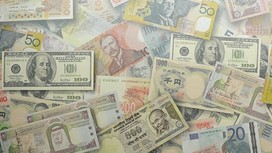In 2008 investors learnt about financial chain reactions. This was not simply because the demise of Lehman Brothers hit other western groups; there was also fallout for emerging market companies.
2008年,投资者领略到了金融连锁反应是怎么回事。这并非仅仅因为雷曼兄弟(Lehman Brothers)的垮台冲击了其他西方集团;新兴市场企业也感受到了冲击波。

Take a look, for example, at a fascinating report issued by the Bank for International Settlements this week. It estimates that after the Lehman shock in 2008, about 50,000 companies in emerging countries such as Brazil, China and Russia suffered $30bn in losses when the dollar suddenly surged in value as a safe haven currency. This was because the companies held derivatives contracts – and while these had seemed safe when the dollar was weak, they unexpectedly produced losses after the Lehman shock because nobody had expected currencies to swing so wildly.
国际清算银行(BIS)最近发表了一份耐人寻味的报告。该报告估算,2008年雷曼冲击波过后,美元作为避险货币突然走高,导致巴西、中国和俄罗斯等新兴市场国家约5万家公司损失300亿美元。这是因为这些公司持有衍生品合约。尽管当美元汇率较低时,这些合约看来是安全的,但雷曼冲击波来袭后,它们意想不到地带来亏损,因为谁也没想到汇率波动幅度竟如此之大。
It is a lesson in unexpected market consequences in a tightly interconnected world. It is particularly timely given that US Federal Reserve officials have this week signalled plans to tighten monetary policy next year – which has, in turn, pushed the dollar to a 17-month high, since higher rates will make US assets more attractive.
在相互联系密切的世界上,这种意想不到的市场后果给我们上了一课。鉴于美联储(Fed)官员最近表示计划于明年收紧货币政策,这一课上得尤其及时。美联储发出的信号把美元汇率推高至17个月高点,因为加息将使美国资产更具吸引力。
This could easily create new shocks. Since 2008, western central banks have kept monetary policy so loose that global investors have gobbled up emerging market assets in a quest for anything that might produce returns. This has led to a striking, but largely unnoticed, shift in the credit ecosystem: whereas companies in Russia, Brazil, China and India used to raise funds by borrowing money from banks, the BIS notes they have increasingly been selling bonds to asset managers instead.
这很可能带来新的冲击波。自2008年以来,西方央行一直维持着如此宽松的货币政策,以至于渴求收益的全球投资者竞相购入新兴市场资产。这导致信贷生态系统发生了一种重大但鲜为人知的变化:国际清算银行注意到,过去通过向银行贷款来融资的俄罗斯、巴西、中国和印度企业,现在越来越多地向资产管理公司出售债券。
This creates a risk: when western rates rise, some of those investment flows into emerging markets could go into reverse, creating unexpected chain reactions. Indeed, a small version occurred last year, when markets swung wildly on speculation that the Fed was about to “taper” its super-loose monetary policy.
这就形成了一种风险:当西方利率升高时,这些流入新兴市场的投资中的一部分可能会回流,带来意想不到的连锁反应。实际上,这一剧情已在去年小规模上演——当人们猜测美联储即将“缩减”其超宽松的货币政策时,市场发生剧烈波动。
One point of concern is that these flows are obscured by data fog. If you look at national statistics for debt issuance, they suggest emerging market companies issued $152bn of new debt last year, creating a total of $650bn in outstanding bonds. However, if you look at reports from companies in China, Russia and India, they imply that outstanding bonds are $1.2tn, with $265bn in bond sales last year.
引起担忧的一点是,这种资金流动被数据迷雾所遮蔽。如果你查看各国的发债统计数据,会发现新兴市场公司去年新发债1520亿美元,使未偿债券总额达到6500亿美元。然而,如果你阅览中国、俄罗斯和印度公司的报告,会发现它们的未偿债券总额达1.2万亿美元,去年发债2650亿美元。
The reason for this dramatic difference is that many companies have sold debt through offshore vehicles, which are hard to track. Worse still, this trend appears to have gone hand in hand with growing currency mismatches, since much of the debt has been sold to foreign investors in dollars – but is being serviced by revenues in domestic currencies.
两者差距如此大,原因在于许多公司通过难以追踪的海外工具发行了债券。但更糟糕的是,这一趋势似乎伴随着日益严重的货币错配——卖给外国投资者的债券大部分是美元债,而发行人使用以本币计价的营收偿还债务。
For some companies – say, big commodity groups in Russia, South Africa or Brazil – this mismatch will matter little as they have easy access to dollars. For others, a dollar swing could pose big risks. Raghuram Rajan, India’s central bank governor, warns of currency mismatches at many large Indian companies. The BIS fears “assets and liabilities are less likely to be matched at property developers in China or energy and utilities firms in India, which have been among the more active international debt issuers in recent years.”
对于某些公司——比如俄罗斯、南非和巴西的大型大宗商品集团——来说,这种货币错配没什么关系,因为它们很容易获得美元。但对其他国家的企业来说,美元汇率波动可能带来重大风险。印度央行行长拉吉拉姆•拉詹(Raghuram Rajan)对许多印度大公司的货币错配提出了警示。国际清算银行担心,“对于中国的房地产开发商或者印度的能源和公用事业公司来说,资产与债务的匹配程度可能更低。近些年,这些公司在国际债券发行方面比较活跃。”
Worse, the asset management industry is highly concentrated, creating a growing tendency for bond investors to act as a herd. The risk, then, is that an Indian or Chinese company defaulting on a bond could create a bigger stampede – and further chain reactions.
更严重的是,资产管理行业高度集中,使得债券投资者发生羊群行为的倾向越来越大。那么风险就在于,如果一家中国或印度公司的债券违约,就可能带来更大规模的“跟风潮”,以及进一步的连锁反应。
Such fears are not new: emerging markets have faced volatile investment flows before. And precisely because of this history, some officials think emerging markets companies are becoming savvier. One cheering detail about the BIS data, for example, is that emerging market companies are issuing bonds of longer maturity. Another is that they seem to be using fewer of the exotic derivatives that caused pain in 2008.
这种担忧不是新鲜事儿:新兴市场以前也经历过反覆无常的投资流动。恰恰因为这一历史,有些官员认为新兴市场企业正变得更加老练。比如,国际清算银行数据中令人振奋的一点是,新兴市场公司所发行债券的期限在延长。另一点是,如今它们似乎减少使用在2008年造成痛苦的复杂衍生品。
Some central bank officials hope last year’s “taper tantrum” has also helped companies and investors to prepare. “The emerging markets have had an entire year to think about the risks,” points out a senior Fed official. “We have signalled our intentions very clearly.”
有些央行官员希望,去年的“缩减恐慌”(taper tantrum)也可能帮助公司和投资者做好了准备。“新兴市场得到了整整一年时间考虑这些风险,”一位美联储官员指出,“我们非常明确地表达了我们的意图。”
But it is one thing to think about risks in theory, quite another to confront a surging dollar and rising US rates in reality. And, as 2008 shows, in an interconnected world shocks have a nasty habit of cropping up where least expected – particularly amid data fog and asset-liability mismatches tucked in corners of the system that policy makers and investors are struggling to understand.
但在理论上思考风险是一回事,在现实中应对美元大幅走高和美国利率升高完全是另一回事。此外,正如2008年的经历所证明的,在彼此联系的世界里,冲击很可能发端于那些最意想不到的地方,尤其是存在数据迷雾和资产-债务错配的情况下。此类错配隐藏在政策制定者和投资者难以理解的金融体系角落里。













